Four students “save” relic near Hoan Kiem Lake

Many people were very surprised when they saw four young girls devoting themselves to clean up the ancient tower of Hoa Phong, a relic on the bank of ${bigcity_Hanoi:"Hanoi"}'s ${attraction_Hoan_Kiem_Lake:”Hoan Kiem Lake”}, on February 21. Located on the east side of Hoan Kiem Lake facing Hanoi Post Office, Hoa Phong Tower is a part of the renowned Bao An Pagoda built in 1842.
At that time Hanoi's Municipal Governor Cum Northern Viceroy Nguyen Dang Giai obtained money for building the pagoda and the structure was then named after him Quan Thuong (high-ranking mandarin). It took four years to complete Bao An. The pagoda faced the Red River and stood beside Hoan Kiem Lake. Located on an area of about 36,000 square meters, the pagoda was a complex of 36 houses including -180 compartments with many corridors, drum and bell pavilions, bridges and towers. In 1892, in order to build new streets in Hanoi, the French dismantled Bao An Pagoda, leaving only the square-shaped Hoa Phong Tower which stood by the pagoda's gate. The tower has four entrances that face four directions, expressing the wish for fine wind during the four seasons. Architecturally, the three-layered tower is small in scale. It is narrower on the top. The four roofs constitute a gourd, symbolizing a miniature sky.
On each of the two opposite entrances there were three Han scripts "Bao Thien Tower" (reciprocating God's favor). On each of the other two there were three Han scripts "Hoa Phong Tower (fine wind). The six-meter-high tower has four interconnected entrances each of 1.1 meters wide; the second layer is 1 meter wide and 1.2 meters high built of bricks from the famous ceramics village of Bat Trang. The third layer is 0.8 meter wide, 1 meter high, and has a 0.8-meter-high roof. The ground level is designed into a square house with a flat roof; on the four corners of the ground level there are four low square columns with four flanking unicorns. On each entrance there are three Han scripts: Bao Phuc Mon (the entrance for reciprocating happiness), Bao An (entrance for reciprocating received favors), Bao Duc (entrance for reciprocating virtue), and Bao Nghia (entrance for reciprocating loyalty), showing the cause-effect theory of Buddhism. As an age-old architectural vestige of Hanoi, Hoa Phong Tower bears imprints of a sorrowful period in the history of the capital city.
Lying in the cluster of cultural vestiges of Hoan Kiem Lake, the tower contributes to the solemnity of the clusters. This is an important relic of Hanoi. However, the relic has been vandalized with graffiti written by visitors. On February 21, four young girls used dau gio (medicinal oil) and cotton to clean up objectionable graffiti on the tower’s walls. They are first-year students from the Hanoi Medicine University and the National University. Thanh Mai, who initiated the idea, said: “Some people think that writing something on the tower is the way to mark their memory but their act is ill-considered and it soils the ancient tower. We simply think that we should wipe out these letters because this is a task within our reach to beautify Hanoi”.
Mai said the idea to clean the graffiti off of Hoa Phong tower with dau gio flashed in her mind and she shared the idea with her close friend Kieu Anh. They were then joined by two other girls named Nga and Hanh. The girls immediately did the job. “We have to study whole day. We only have 1-2 free hours for this task. We planned to clean graffiti written with correction pens and then use alcohol to clean what was written with felt pens,” a girl said. “We were afraid that guards would not allow us to do this so we prepared argument to convene them,” Nga said. Visitors who witnessed the four girls’ simple but ‘knightly’ act showed their admiration for the girls. Mai Huong, a tour guide said: “I’m astonished by their initiative.
Though the act is not huge but no one else thought of it and did it”. Shawn, a tourist from New Zealand, commented: “The people who wrote graffiti on the tower are so bad but these girls are wonderful. I admire them! They are good images of Vietnamese girls”. Uwe Schwarten, a German visitor, enthusiastically joined the group. “This is my first visit to Vietnam. A valuable relic like this should not be treated that way. I understand the good job that these girls are doing. Their act is very lovely!” he said. The girls were also surprised to see people’s support. “We are trying to finish this job soon and I hope that after the tower is cleaned, people will preserve it together. I hope that people will not write on the tower,” said Thanh Mai.









